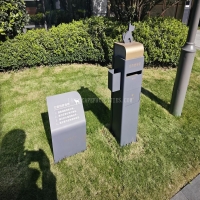Welcome to the website for landscape facilities products and knowledge.
How does the design of a landscape round trash can impact its resistance to damage from high-pressure washing?
The design of a landscape round trash can plays a critical role in its ability to withstand high-pressure washing, a common maintenance practice for outdoor waste bins. A well-engineered round trash can incorporates several key features to ensure durability.
First, the material selection is paramount. High-density polyethylene (HDPE) or powder-coated metal are often used for their resistance to corrosion, cracking, and fading under intense water pressure. These materials also prevent rust and maintain structural integrity over time.
Second, the seamless or welded construction of the trash can eliminates weak points where water could penetrate or cause damage. Rounded edges and smooth surfaces reduce the risk of chipping or peeling, which is common in angular designs.
Additionally, reinforced bases and weighted bottoms provide stability during high-pressure washing, preventing the bin from tipping over or shifting. Proper drainage holes are also integrated to avoid water accumulation, which can lead to mold or weakening of the material.
Finally, the ergonomic design of a landscape round trash can ensures even distribution of pressure during cleaning, minimizing stress on any single area. This thoughtful engineering extends the lifespan of the bin, making it a reliable choice for high-traffic outdoor environments.
By prioritizing these design elements, manufacturers create trash cans that not only endure rigorous cleaning but also maintain their aesthetic appeal and functionality for years.
Related search:

Recommendation
Outdoor cat and dog feces trash can; Community pet trash can; Metal multi-color design